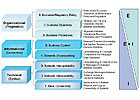Imagine a time in the near future when building owners manage electric demand by participating in a more efficient and environmentally friendly operation of the electric power grid. This will require technology acting on their behalf, in response to information from other components of the electric system. The technology will recognize operator preferences to parameters such as comfort and the price of energy, to form responses that optimize the local need with a signal that satisfies a higher-level need in the grid.
Interconnected electric power systems are composed of many businesses cooperating to deliver electricity to the consumer. Today’s technology offers the ability to exchange information to enhance operational and financial effectiveness. Incentives to exchange information electronically are the result of system and business processes that span organizations such as scheduling and coordinating electric supply and demand-side resources.

The Framework Of Interoperability
Yet integrating many different information systems poses an obstacle. The “distance to integrate” can increase costs and create risks to realizing new business opportunities. To facilitate information exchange, the GridWise™ Architecture Council (GWAC) promotes a collaborative path forward to advance interoperability, shrinking the distance to integrate, and allowing organizations to better connect their inter-business processes as they see fit now and as they evolve in the future.GWAC's mission is to enable interoperability among all entities that interact with the electric power system2. Interoperability is when “two or more networks, systems, devices, applications, or components exchange information between them and use the information so exchanged”3.
To move toward interoperability, the GWAC engaged cross-sector industry experts to help develop an interoperability framework to organize concepts and terminology so that interoperability issues can be identified and debated, improvements to address issues articulated, and actions prioritized and coordinated across the electric power community.
The GWAC first engaged the electric system community to develop a set of interoperability principles4, the GridWise Constitution, with broad industry agreement. Building upon those interoperability principles, the framework focuses on the interface between two or more interacting parties.
GWAC emphasizes the independence of information technology choices and solution approaches to the business that occurs on either side of the interface. The goal is to improve the system integrator’s job to hook-up and configure the interacting components so that they perform properly. The framework identifies eight interoperability categories relevant to the mission of systems integration and interoperation in electrical generation, delivery, and enduse. Major aspects for discussing interoperability are technical, informational, and organizational.
Integrators are familiar with interoperation agreements at the interface technical layers. This encompasses the physical transmission of information, communications protocols, and data syntax. Information about real-world application is embedded into technical layers. In the informational layers, we develop informational models that reflect knowledge about things relevant to the information exchange. How these things are related to one another is also described and perhaps how they are related to similar entities across different business domains.
Organizational layers are the drivers for connectivity. Interoperability requires agreement on the business process interaction that takes place across an interface, and describes the service requests and responses needed to support a larger process picture shared by the collaborating parties5. These processes must also be consistent with the tactical aspects of running the businesses, the strategic aspects shared by the parties of the exchange, and the political environment embodied in economic and regulatory policy that governs such business.
Figure 1 depicts these categories of interoperability, with those at the bottom focusing almost entirely on information technology (I), but as we rise through the informational layers to the organizational layers, the emphasis becomes electricity (E).
To improve system integration, cross cutting issues need to be resolved across the interoperability layers, which are relevant to multiple layers in the framework. These issues need to be addressed to achieve interoperation and warrant detailed investigation in the context of an interoperability framework for the electric system. These include shared meaning of content; resource identification; time synchronization and sequencing; security and privacy; logging and auditing; transaction and state management; system preservation; performance, reliability, and scalability; discovery and configuration; and system evolution.
The framework is a start to bring together stakeholders in the electricity community. More work is needed to control the evolution of interoperability concepts and principles over time. New material must address different audiences including intelligent building integrators, regulators, business decisionmakers, and system suppliers. The framework provides a technical foundation to interoperability concerns to engage a wider audience.
On November 7-9, 2007, the GWAC will host Grid Interop in Albuquerque, NM (www.gridwiseac.org). This gathering will engage all sectors of the electricity community to address interoperability issues and take steps to enable all elements of the electric system to become one with the grid. GIB
Works Cited
1. Pratt, R., “Transforming the Electric Energy System,” Proc. of 2004 IEEE PES Power Systems Conference and Exhibition, New York, October 2004.2. Hamilton, S.L., E.W. Gunther, R.V. Drummond, S.E. Widergren, “Interoperability: A Key Element for the Grid and DER of the Future,” IEEE PES T&D Conference 2005/2006, May 21-24, 2006: 927 – 931.
3. European Industry Association, “EICTA Interoperability White Paper,” Information Systems Communication Technologies Consumer Electronics, June 21, 2004.
4. GridWise™ Architecture Council, “Interoperability Constitution Whitepaper,” October 2005, www.gridwiseac.org.
5.GridWise™ Architecture Council, “Interoperability Context-Setting Framework,” July 2007, www.gridwiseac.org.
